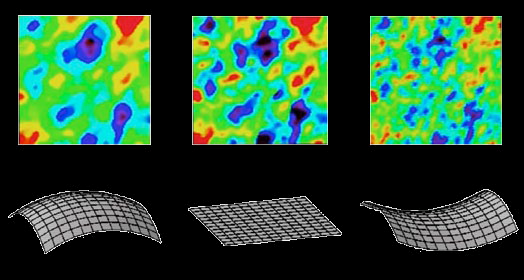A Flat Universe After All
Flatness can be good or bad. Flat champagne or a flat tire is not good. On the other hand, everybody seems to want a flat stomach.
Many astronomers yearn for a flat universe. In fact, they’ve been on such a quest for forty years. That’s because cosmic geometry carries important implications for life and for cosmic design and age.
Wilkinson Microwave Anisotropy Probe (WMAP) measurements of the cosmic microwave background (CMB) radiation (radiation left over from the cosmic creation event) made over a seven-year period tell us that the time back to the beginning of the universe is 13.75 ± 0.11 billion years.1 However, one (and only one) assumption underlies this cosmic age determination: that the universe departs by no more than one or two percent from a perfectly flat geometry. The CMB temperature fluctuations provide a rough indication that the universe manifests a flat geometry (see figure). Specifically, the data sets from the WMAP placed these limits on the universe’s curvature, Ωk. Where Ωk = 0 defines perfect flatness, the best measurements showed Ωk to lie between –0.199 and 0.017.2
Researchers anticipated that better constraints on the universe’s geometry would be possible if and when astronomers could (1) make precise observations of the cosmic expansion rate(s) throughout cosmic history, and (2) determine the power spectrum of luminous red galaxies over a sufficiently large extent of the observable universe. I’m pleased to report that in recent months, the desired level of precision has been achieved.
In August 2011 the Supernova Legacy Survey team published results showing that Ωk = –0.002 ± 0.006.3 In February of 2012 the Hubble Space Telescope Cluster Supernova Survey team determined that Ωk = 0.002 ± 0.005.4 A combination of these two results confirms that the universe possesses a flat geometry—to within three places of the decimal (much less than one percent). Now that astronomers have established the veracity of the cosmic flatness assumption, no scientific doubt remains that the universe came into existence about 13.75 billion years ago.
According to the latest findings, in the infinitesimally brief moments after its creation, the universe experienced a hyperinflation event, during which it grew from one hundred million trillion times smaller than the diameter of a proton to about the size of a grapefruit. Evidence for that event came initially from a WMAP measurement of the cosmic scalar spectral index.5 New measurements establishing cosmic flatness provide a confirming piece of evidence.
Left: Ωk < 0; center: Ωk = 0; right: Ωk > 0
Ωk = 1 – Ωm – ΩΛ
Figure: Geometry of the Universe
Angular sizes of the temperature fluctuations in the cosmic microwave background radiation reveal the “shape,” Ωk, of the cosmic space surface. Galaxy survey maps and cosmic expansion-rate measurements throughout cosmic history independently establish the universe’s geometry by determining the values of Ωm, the cosmic mass density, and ΩΛ, the cosmic space energy density).
Image credit: NASA
What It Means
Cosmic flatness adds one more layer of support to the case for a cosmic origin scenario perfectly aligned with the biblical creation account.6 It speaks of God’s supernatural design of the cosmos—including its specific age and a specific geometry—for humanity’s benefit. (Reasons for tight constraints on cosmic age, size, homogeneity, and uniformity for humanity’s sake are explained more fully in my books, Why the Universe Is the Way It Is and The Creator and the Cosmos, 3rd edition.)
Endnotes
- N. Jarosik et al., “Seven-Year Wilkinson Microwave Anisotropy Probe (WMAP) Observations: Sky Maps, Systematic Errors, and Basic Results,” Astrophysical Journal Supplement 192 (February 2011): 14.
- E. Komatsu et al., “Seven-Year Wilkinson Microwave Anisotropy Probe (WMAP) Observations: Cosmological Interpretation,” Astrophysical Journal Supplement 192 (February 2011): 18; E. Komatsu et al., “Five-Year Wilkinson Microwave Anisotropy Probe (WMAP) Observations: Cosmological Constraints,” Astrophysical Journal Supplement 180 (February 2009): 330–76.
- M. Sullivan et al., “SNLS3: Constraints on Dark Energy Combining the Supernova Legacy Survey Three-Year Data with Other Probes,” Astrophysical Journal 737 (August 20, 2011): 102.
- N. Suzuki et al., “The Hubble Space Telescope Cluster Supernova Survey. V. Improving the Dark-Energy Constraints Above z > 1 and Building an Early-Type-Hosted Supernova Sample,” Astrophysical Journal 746 (February 10, 2012): 85.
- Jarosik, “Seven-Year WMAP Observations.”
- Hugh Ross, A Matter of Days (Colorado Springs: NavPress, 2004), 139–48.







